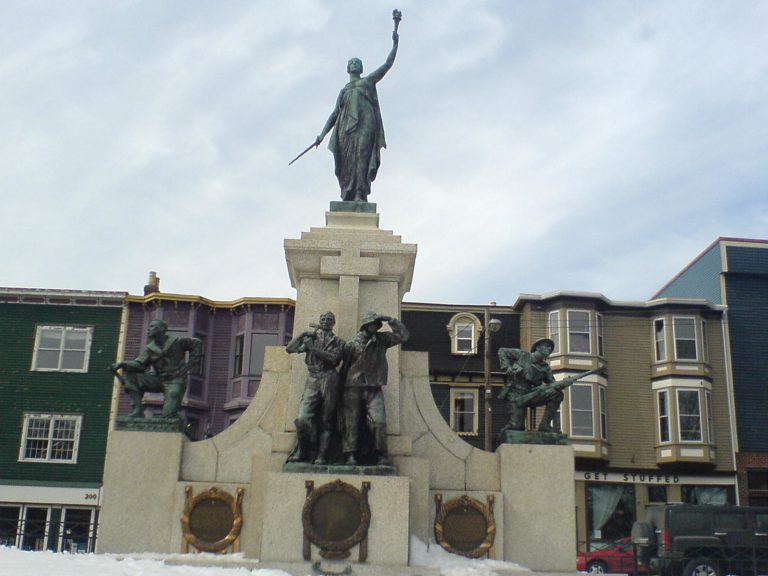Place Category: Monument
Designated 2019.
Unveiled in 1924 to commemorate the Dominion of Newfoundland’s contributions to the First World War, the Newfoundland National War Memorial is an imposing monument featuring a rare combination of allegorical and realistic bronze sculptures designed by British artists Gilbert Bayes and Ferdinand Victor Blundstone. Its design elevates a victorious Spirit of Newfoundland over figures of a sailor from the Newfoundland Royal Naval Reserve, a soldier from Royal Newfoundland Regiment, a lumberman from the Forestry Corps, and a fisherman in oilskins and Wellington boots, providing a tangible connection to Newfoundland and Labrador and those who served overseas and on the home front. Located next to where Newfoundland soldiers departed and returned from the First World War, it is a physical and visual landmark in downtown St. John’s.
The memorial features five bronze sculptures on a large granite base, the largest of which, a female figure representing the Spirit of Newfoundland who holds a flaming torch in her left hand high above her head, stands atop the central pedestal. The torch, which symbolizes freedom, is the memorial’s highest point, prioritizing freedom as a central motivation for Newfoundland’s wartime contributions. In her right hand, she holds a sword which represents both Newfoundland’s willingness to serve during the First World War and loyalty to the British Empire. The sword is below her waist, but not completely lowered, and poised for battle, and is meant to depict that while the war is over, Newfoundland was, and is, ready and willing to fight for its freedom and liberty.
On the front of the monument below the figures are five plaques commemorating Newfoundland and Labrador’s contributions in different conflicts. In the centre, the original plaque from 1924 honours those killed during the First World War. Plaques for the Second World War, Korean War, Afghanistan, and War of 1812 have been added.
The monument sits between Water and Duckworth streets. While the city’s natural topography slopes towards St. John’s Harbour, the grade at the site was altered prior to construction with the slope making the monument appear larger and more imposing in its setting. This visual effect extends to St. John’s Harbour and gives the memorial a grand appearance when seen from the water. The flaming torch held by the Spirit of Newfoundland figure was originally intended to be a leading light for ships entering St. John’s Harbour through the Narrows, although it was never used as such.
The location also has historic significance as it was where Sir Humphrey Gilbert claimed Newfoundland for England in 1583. The memorial is also located where the Custom House stood before the Great Fire of 1892 destroyed most of downtown St. John’s. (Source: Parks Canada Backgrounder, 2019.)
No Records Found
Sorry, no records were found. Please adjust your search criteria and try again.
Google Map Not Loaded
Sorry, unable to load Google Maps API.

